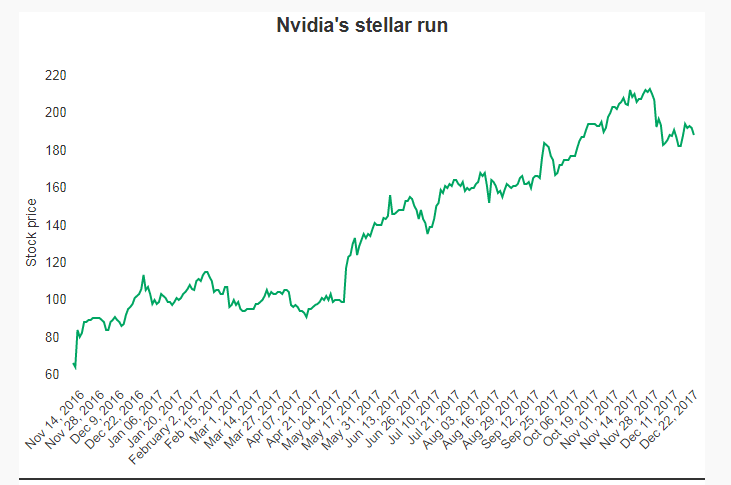
This article is produced by NetEase Smart Studio (public number smartman 163). Focus on AI and read the next big era!
[Netease smart news December 27 news] this year, Nvidia's share price has risen sharply, because of its application in all areas there has been a huge demand, including games, databases, and its main applications in the field of artificial intelligence .
However, although Nvidia's stock price and its chart are already among the most dazzling events in 2017, in the field of artificial intelligence, the pace of artificial intelligence development continues, but the situation is more subtle and may have far-reaching consequences.
This year, a large number of startups began to develop their own hardware to provide support for future artificial intelligence infrastructure, and these companies have received huge amounts of financing. Some of these start-up companies have not even released products, but it seems that there is no difficulty in financing.
To optimize reasoning and machine training—two key parts of the process of image and speech recognition—these startup companies are researching faster and more efficiently, and are better suited to the next generation of artificial intelligence devices. Compared to CPUs, which we are accustomed to using, the GPUs have become the first choice for fast calculations needed to process artificial intelligence. These startups think they will make better products.
Before we get to know these startups, let's quickly review the previous Nvidia stock price chart to find out about this matter. Even at the end of the year, Nvidia's stock price is still up nearly 80% when it is about to reach 2018:

Therefore, naturally, we will probably see a group of start-up companies trying to find the potential loopholes in the artificial intelligence market of Nvidia. Investors will also notice this.
The first news we got was that in December of last year, Cerebras Systems Company obtained approximately $25 million in financing from Benchmark Capital. At the time, it seemed that the artificial intelligence chip industry was not as popular as it is today — but, over time, Nvidia’s dominance in the GPU market has clearly demonstrated that this will be a booming area. In August of this year, Forbes magazine reported that the company’s valuation is close to 900 million U.S. dollars.
This year, Graphcore also caused some sensation. The company announced the acquisition of US$5,000 in Sequoia Capital shortly after it announced that it had secured a US$30 million Series A round of financing. And like Cerebras Systems, Graphcore does not have a compelling product on the market like Nvidia. Although the challenges facing hardware startups are much greater than those of software development companies, the startup still raised $80 million in funding within a year.
In addition, Chinese artificial intelligence startups have also received substantial financial support: Alibaba has invested heavily in a startup called Cambricon Technology; Intel invested $100 million in Horizon Robotics; earlier this month, it was called ThinkForce. The startup company raised $68 million in investment.
Groq, a start-up company run by a former Google engineer, raised about $10 million from Social+Capital, which appears to be a bit smaller than the startups listed above. Another chip maker, Mythic, also completed a $930 million financing.
Therefore, we can see that more than one or two start-up companies are doing business in this area, many of which have already raised tens of millions of dollars, and even one startup has a valuation of about US$900 million. These new generation of hardware startups will also need more investment. This is still a part that cannot be ignored.
In addition to startups, the world’s largest companies are also seeking to develop their own systems. In May of this year, Google released the next-generation TPU for reasoning and machine training. Apple designed its own GPU for the next generation of iPhones. Both products will greatly help to adjust the hardware for user-specific needs, such as Google Cloud Apps or Siri Assistant. Intel also said in October that it will launch a new neural network processor by the end of 2017. Last August, Intel acquired Nervana for $350 million.
All these are great efforts made by startups and big companies, and each company is looking for its own definition of GPU. However, for Nvidia who has locked developers on its platform, this task may be even more daunting. This is even more true for startups that are trying to push hardware development into madness and involve developers in it.
Perhaps when you talk to investors in Silicon Valley, you still have some doubts. For example, when the old cards on the Amazon server can still be used for their training, why do companies consider buying faster chips for training? But there is still a lot of money flowing into the field, such as Uber (although the company has had a lot of turmoil recently) and big companies like WhatsApp.
Nvidia is still the leader in this field, and as devices such as self-driving cars become more and more important, the company will continue to work hard to maintain its dominant position. But as we enter 2018, we may begin to better understand whether these startups really have the opportunity to displace Nvidia. This is a tempting opportunity to create faster, lower-power chips to enter the realm of the Internet of Things and truly implement the role of these devices to achieve more efficient reasoning. And, when they want to train models, they also have the opportunity to make these servers faster, more energy-efficient, and more powerful.
(From: TechCrunch Compilation: NetEase See Compiled Robot Review: Rain Egg)
Pay attention to NetEase smart public number (smartman163), obtain the latest report of artificial intelligence industry.
Truck Led Display,Mobile Led Billboard,Truck Mounted Led Screen,Truck Led Screen
ShenZhen Megagem Tech Co.,Ltd , https://www.megleddisplay.com